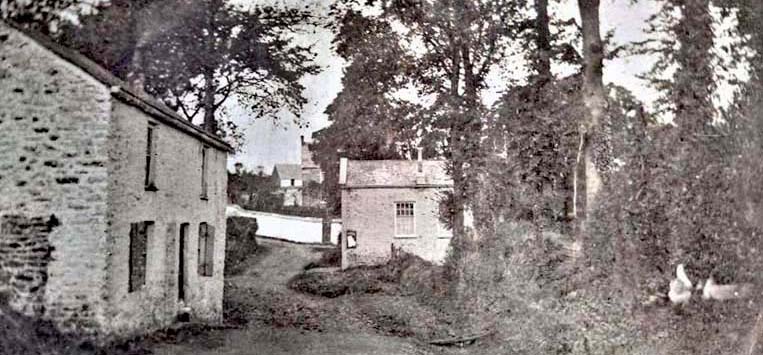
Susan Coney (née Phillips) is a prolific researcher and recorder of local history, especially about Truro. Here, she shares with us her memories of growing up during the 1940s to the 1960s, recalled and recorded during the 2020 Covid-19 lockdown. These articles will appear as a series over the coming months with this first one relating to her early years.
The lead photograph shows The Cottage, Idless (on the left), where I was born, with the chapel on the right.
I was born ‘down’ Idless in the middle of a snowstorm at the end of December 1946 – my grandmother delivered me as Dr Hood couldn’t get out to Idless because of the snow. I was born in the ‘front room’ and I think the first thing I saw was the roaring fire which was only usually lit on high days and holidays. Our ‘two up, two down’ cottage was the one right on the roadside in the middle of the village. Our water was from the village ‘tap’, lighting was oil lamps and candles. Our toilet was across the road in our small garden.
When I was a few months old, I was put out in the garden in my pram for some fresh air and a nap – I remember watching the birds and sometimes one would perch on the pram handle – no need for a baby mobile to keep me amused.
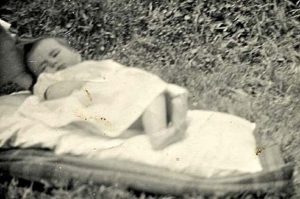
Mum cooked on a Cornish range in the kitchen in which she or my grandmother baked the best pasties ever. We had chickens in the garden and Dad grew vegetables as most everyone did in those days.
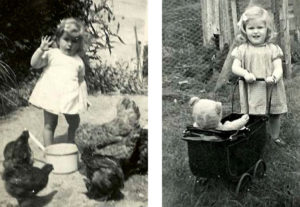
Dad went to work at Truro Garages on his bicycle – I think he cycled home for his dinner at one o’clock. My Dad and his family (from Penelewey) came to live in Idless in the late 1920s when his Dad got a job driving a steam lorry at Idless woods (he had previously worked in the mines near Goonbell). They lived in one of the cottages (the far one) which are by the entrance to the woods.
The villagers were all ‘locals’: many were related, some directly and some by marriage. Everyone knew each other – I remember the Davys, Cocks, Williams, two families called Bennett, Richards, Eslicks, Hollaway, Hocking and Mitchell (the names might not be spelt correctly). Some of the village men, including my Dad and Uncle, used to play cards at the Davy’s. My Uncle Ern (a market gardener) and Auntie Winnie lived in the cottage on the village side of the Eslick’s farm. In the late 1940s and early 1950s we used to have a village carnival and one year, when I was about three, I was Nell Gwyn, with a basket of oranges, and my brother was a minstrel.
 Idless Carnival in about 1949
Idless Carnival in about 1949
Another person I remember was known to me as Raggs. His full name was Robert E Ragg, an artist and a potter who had exhibited at the Royal Academy. He was well-known and respected in the village and lodged at Idless farm. One day Raggs went missing so some men from the village went up to his studio (a wooden shack) in the copse off the lane behind Mill and found that he had committed suicide. A sad day for all the village. I am proud to say that I have a pottery cat made by Raggs which had cracked in the kiln so could not be offered for sale: it is one of my most precious memorabilia.
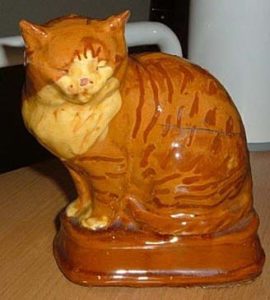 Ragg’s cat
Ragg’s cat
Every Sunday we went to Idless Chapel where my Auntie Dor (Doris) played the organ. My Auntie Dor lived in the village with her son Barry (Butch), her brother Reg and young sister Olga, a nurse who trained at the RCI (Royal Cornwall Infirmary).
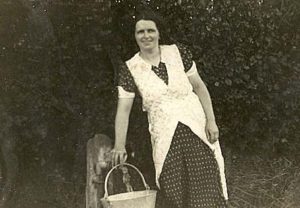 Aunt Dor fetching water from the village tap
Aunt Dor fetching water from the village tap
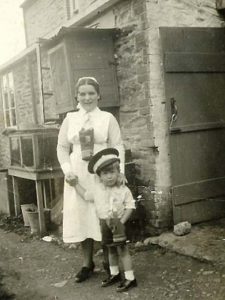 Auntie Olga with Barry
Auntie Olga with Barry
Next door to us lived my cousins, Mona and Bill Polkinghorne and their daughter, Marina. Marina was my playmate and we used to play post offices through her tall garden gate using pennyworts as money. Mum used to take me for walks along the lane to Penmount or up the hill towards Shortlanesend going past another Aunt’s farm at Higher Carvinack (Cavarnick as we pronounce it) then down the narrow road (past the old quarry – which to me was a bit scary) to Higher Lamerton Farm and back into Idless. Mum used to teach me the names of all the trees and wildflowers which I have never forgotten.
My brother, who was six years older than me, from aged five, cycled to St Mary’s School in Truro. He left his bike at my Auntie Kitty’s house in Trehaverne. He once had a pigeon which he found injured. It was kept in a box in the kitchen until it recovered and was then set free, but it never really left us. Every morning, the pigeon would perch on my brother’s handlebars and stay there until he reached the bottom of Bishop’s Hill. The pigeon then flew back to our cottage and perched on the gate opposite, so Mum knew that my brother was nearly at school. Every afternoon at school time, the pigeon would fly off and find my brother and sit on his handlebars for a ride home. Amazing but true.
We also had a fox cub for a short while. On a warm day, Mum would leave the front door open and one day was aware that something had run into the kitchen and was cowering under the table. Mum then heard the hunt with their pack of hounds coming into the village, so she quickly shut the door. The hounds were barking and jumping up at the door and windows. One of the huntsmen knocked on the window and said, ‘You must have the fox in your house’. Mum said, ‘Don’t be silly, how can a fox get in here when the doors and windows are shut!’ Eventually, the hounds were called off and the hunt went off down the road. When Mum looked under the table, it was a young cub. We kept it for a short time and fed it with scraps until it got a bit bigger, then let it free in the woods.
Some of the boys from the village used to go up into the woods. They often lit a fire and cooked sausages (supplied by my Aunt). My brother was in the scouts (with Barry Eslick) so he had been taught how to set a fire and put it out safely, but my Dad often went up to the woods later to make sure the fire was out!
I loved cats and the two spinster ladies (the Miss Richards) who lived in the cottage next to my Aunt, had several cats who often had a litter of kittens. One of the cats had kittens in the loft and would not allow anyone to look in through the hatch to see them – except me! The Miss Richards used to ask me in and I would climb up the steps and look into the loft and the cat would bring each of her kittens over to let me pet them. No one else could go near them, even the Miss Richards.

Mum and I went into town about once a week – Mum pushing me in a pushchair or maybe catching the bus which ran once a week, I think. Mum would do a bit of shopping, maybe in Slaters, Crowle and Moss, and sometimes Roberts (I don’t remember going into Gills where Mum used to work – I expect it was sad for her to see the store being run down). Mum may have bumped into one of her old friends and had a chat but not for long as I used to get fed up and teasy. I was never allowed to eat anything in town not even a sweet.
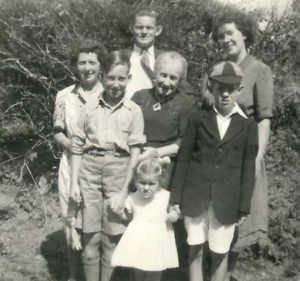 Circa 1948: Dad, Mum, my Grandmother, Nanny Truscott, my brother (in the cap), my Aunt and her son and me
Circa 1948: Dad, Mum, my Grandmother, Nanny Truscott, my brother (in the cap), my Aunt and her son and me
When I was four-and-a-half we were given one of the first four Council Houses in Shortlanesend. We were ‘top of the list’ due to Dad’s war work. We had mains water and electricity, a bathroom and another toilet in the ‘back-house’ where there was a coal house and washhouse – we also had a big garden. I recently found out that these houses, and many more around Truro of the same era, were designed by Alfred Cornelius, the architect and assistant to Silvanus Trevail who took over Trevail’s business when he died.
 Alfred Cornelius’ plan
Alfred Cornelius’ plan
That’s my fond memories of my early childhood. Memories of growing up in Shortlanesend is for another time.
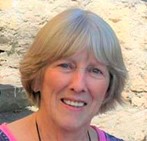 Susan Alecia Coney (nee Phillips)
Susan Alecia Coney (nee Phillips)
I was never very interested in history at school but following retirement, I decided to trace my family history. I had told my Mum that I intended to do so, and her reply was ‘I wouldn’t bother m’dear – we know zactly where we come from – a long line of serfs’, which we do.
However, I wanted to find out if the family stories were true – and they all are. I also wanted to find out why I, and most of my family, feel so passionate about being Cornish – which we are, going back many generations.
That was the start of being interested in history – especially Cornish history, of its peoples and places. My Cornish family may not be descended from the rich and famous, but our ancestors were incredible people.
For me, it is important to document one’s research and personal memories for future generations.

Hello Susan.
Lovely to read about your memories. My great grandmother was from Truro. Her name was Tabitha Phillips. All I know is some of her brothers and sisters went to San Francisco USA to live and prospered but Edwin came back to Truro when he was old and died there. I have some letters. Maybe we are long lost cousins?
I must visit Cornwall one of these days! Would love to hear from you. Or anybody else. !
Hello Vanessa – thank you for your comment about my stories. I don’t recall the name Tabitha Phillips but I’ll see if I can find any connection. There are many Phillips families in Cornwall but you never know. Have you got any dates for your great grandmother or her brothers? – that will help me tracing them.
My email is yellowsoo2@btinternet.com
best wishes Susan
Thank you for your writings about growing up in Cornwall. I am feeling every nostalgic for the past since everything is getting so unnatural and chaotic and hectic and the news is all doom and we seem to have let dodgy idiots get too much political power. We had less and were happier and left to our own devices mostly I think as adults and as kids and had more family around usually. Kids today have lots of gadgets but we roamed free. Maybe one day it’ll get back to something more like it was. Best wishes from one serf to another, Claire xxxxxxx
I’ve been very interested in your blog posts about Shortlanesend and Kenwyn. We moved into Willow Cottage, formally Meadow view, opposite Royal Kenwyn yard about 3 and a half years ago. I’ve been struggling to find anything out about the history of the place. I know it’s over 200 years old, and had something to do with the tin trade a long time ago, but that’s just what I’ve been told by David across the road. My grandfather is Albert Reed who opened Reed’s Chemist in town many years ago, and I’ve lived in Truro all my life. I’d be really interested if you knew anything as you seem to have known most of the people around the area at one time or another. Thanks again for the interesting read!
My late husband’s uncle was Robert E Ragg (Raggs) .the artist and potter. All I know is a little about his life and death but there is no one left in the family to ask. I have two of his paintings and one of my husband as a child. We lived in Cornwall for 19 years 2003/2019 but didn’t manage to find any more information about him. Hope to know more
Many thanks Jenny Ragg
Hello Jenny – good to hear from you,
Robert E Ragg – affectionately known as Raggs to the villagers in Idless, was very well known and respected in the village and in Truro.
He lodged at Idless Farm which was owned by Willy and Lillie Mitchell. The farmhouse (now a listed building) is still there as are the old barns (now converted into holiday lets). The grandson of Willy and Lilly still lives and farms in the village but not at Idless farm.
Willy and Lilly’s son Brian died not long ago. He was in his 90s. He still had many of Raggs paintings hanging in his house and I expect they are still there.
I have a photo of one of Raggs paintings and a self-portrait and newspaper cuttings too which you might like to see. I will email them to you.
Raggs was a tutor for pottery at evening collage in Truro.
I do remember Raggs although I was only 5 when he died (aged 29). We lived next door to Idless farm. I remember him as being a quiet man but friendly with a mop of reddish hair. It was so sad when he died – all the villagers were in shock. Raggs had a shed in the small wood just outside the village where he used to do his pottery – that’s where they found him. All the villagers went to look for him when he went missing and it was one of my uncles who found him.
Best wishes
Susan